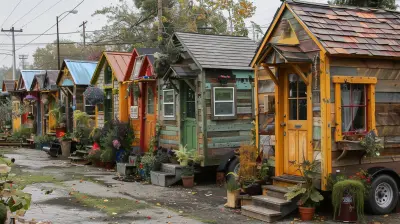How to Flip Houses in Different States: What You Need to Know
20 September 2025
Flipping houses isn't just a real estate strategy; it's a blend of creativity, patience, and a little bit of guts. If you've ever thought about diving into house flipping, you might be wondering whether you should stick to your home state or venture into other markets. The truth is, house flipping can be incredibly lucrative—no matter where you do it—as long as you know what you're getting into.
But flipping houses in different states comes with its own set of challenges. From understanding local laws to managing renovations remotely, there’s a lot to consider. Don't worry, though—I’ve got you covered! Let’s break it down step by step. 
Why Flip Houses in Different States?
You might be thinking, “Why would I flip houses somewhere far from home?” Well, sometimes, your local market just isn't the best place for flipping. Here’s why branching out might be a smart move:1. Better Real Estate Markets
Not all markets are created equal. Some states have booming housing markets, while others are slower-paced. If your local area has high home prices and low profit margins, it might be time to look elsewhere for better opportunities.2. Lower Costs and Higher Profits
Some states have lower property taxes, affordable housing, and cheaper labor costs. This can make flipping houses more cost-effective. Imagine buying a fixer-upper for $100,000 in a growing market, putting in $30,000 in renovations, and selling it for $200,000—sounds like a solid deal, right?3. Diversification of Investments
Relying on one market can be risky. By flipping homes in different states, you're spreading your investments across multiple areas, reducing the chances of a financial hit if one market crashes.
Step-by-Step Guide to Flipping Houses in Different States
Okay, so you're convinced that flipping houses in a different state might be worth it. But how do you actually do it? Here’s a simple step-by-step guide:1. Research the Market
The first rule of real estate investing: Know your market.Each state has its own housing trends, demand, and pricing. You need to find a market where:
- Home values are rising
- There’s a demand for updated properties
- Renovation costs are manageable
- The local economy is strong
Some states, like Texas, Florida, and North Carolina, are known for being great markets for house flipping due to high demand and affordability.
2. Understand Local Laws
Real estate laws vary from state to state. Some states have strict property regulations, while others are more relaxed. Before buying a property, check for:- Property taxes
- Zoning laws
- House flipping restrictions (some areas require you to own the property for a certain time before selling)
- Contractor licensing requirements
Skipping this step can lead to expensive surprises down the road.
3. Set Up a Local Team
Unless you plan on flying out every weekend to check on your property, you’ll need a solid team on the ground. Your dream team should include:- A real estate agent who understands the local market
- A trustworthy contractor for renovations
- A home inspector to ensure you don’t buy a money pit
- A property manager (if needed) to handle the sale or rental process
When you have a reliable team in place, flipping remotely becomes much easier.
4. Find the Right Property
Now, it’s time to find a house with good flipping potential. The ideal property is:- Below market value – You want a deal, not a money trap!
- In a desirable location – Even the best renovation won’t sell in a bad neighborhood.
- Needing cosmetic upgrades, not major repairs – Replacing a roof or fixing the foundation can eat up your profits fast.
Use online real estate platforms like Zillow, Redfin, and Realtor.com to start your search.
5. Secure Financing
How are you planning to pay for the flip? Your financing options include:- Cash – If you have it, it's the fastest and easiest way.
- Hard money loans – Short-term loans ideal for house flippers.
- Conventional loans – Traditional bank loans work but may take longer.
- Private investors – If you know people willing to invest, this could be an option.
Make sure you include all potential costs—purchase, renovations, holding costs, and resale fees—when budgeting.
6. Manage Renovations Efficiently
Since you're not local, managing renovations from afar can be tough. Here’s how to keep things in check:- Get multiple bids from contractors before hiring one.
- Have a project manager or real estate agent oversee renovations.
- Use video calls, progress photos, and contractor updates to stay informed.
- Stick to a timeline to avoid extra holding costs.
Managing a flip remotely isn't impossible—it just requires some extra planning.
7. Price It Right and Sell Quickly
Once renovations are done, it’s time to list the property. To sell fast and maximize profits:- Price it competitively based on recent comps (comparable home sales).
- Use professional photography for online listings.
- Work with a top real estate agent who specializes in the area.
- Consider staging the home to make it more appealing.
A well-priced, move-in-ready home will attract buyers quickly, helping you close the deal faster. 
Common Challenges and How to Overcome Them
Flipping homes in different states isn’t all sunshine and profits. Here are some common challenges and how you can tackle them:1. Unexpected Renovation Issues
A home might look fine at first glance, but surprise issues can pop up—like mold, plumbing problems, or structural issues. Avoid this by always getting a detailed inspection before buying.2. Managing Projects from Afar
Not being there in person can make things tricky. Regular communication with your team and hiring reliable professionals will save you headaches.3. Market Fluctuations
If the market slows down before you sell, your profits might shrink. Avoid this by researching trends and having backup plans (like renting the property if it doesn’t sell fast).4. Legal Complications
Different states have different real estate laws. Always work with a local attorney and real estate agent to ensure compliance.
Is Flipping Houses in Different States Worth It?
Absolutely—if you do it right! The key is thorough research, a strong local team, and smart financial planning. Sure, it can be a bit more challenging than flipping in your backyard, but if you find the right market, the profit potential can be huge.So, what’s stopping you? Start scouting for opportunities, build your network, and take that first step toward flipping houses in different states. Who knows? Your next big real estate deal could be just a plane ride away!
all images in this post were generated using AI tools
Category:
House FlippingAuthor:

Kingston Estes
Discussion
rate this article
1 comments
Gabriella Navarro
Great insights! Flipping houses across different states can be challenging but also incredibly rewarding. Embrace the unique opportunities each location offers, and remember that adaptability is key to your success. Keep pushing forward!
September 22, 2025 at 2:46 AM

Kingston Estes
Thank you for your encouraging words! Embracing local opportunities and staying adaptable are indeed crucial for success in house flipping across states.


